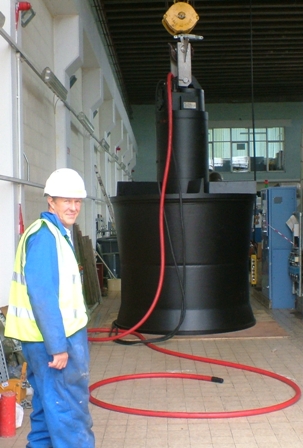Bedford Pumps Ltd has completed its largest project to date with the refurbishment of the pumps and MCC at Altmouth Pumping Station, situated at the mouth of the River Alt in Merseyside.
The Altmouth Pumping Station reduces the risk of flooding to more than 9000 properties and provides protection to approximately 20 square miles of grade A agricultural land.
The low-lying surrounding area of Formby, just South of Southport has a history of flooding since the land was reclaimed from the sea by local monks in the 13th century. Following extensive flooding in the mid 1950’s the Altmouth Pumping Station was constructed in 1972 to drain the land for agricultural purposes and at that time was the largest station of its type in Europe. Due to its age and the condition of the pumping equipment the decision was made to invest £10.7m refurbishing the site.

The pumping station used both storm and dry weather flow pumps which had come to the end of their design life and were becoming increasingly expensive to maintain. The Environment Agency put its MEICA (Mechanical, Electrical, Instrumentation, Control and Automation) team forward to work with the key suppliers in finalising the design for Altmouth. Bedford Pumps provided early contractor involvement (ECI) during the initial conceptual design stage back in 2005, and during the outline design and performance specification development stage following the scheme approval in 2007.
The four original storm pumps were each driven by 1800 hp diesel engines and pumped a nominal 19.8m3/s of water per pump. The storm pumps were operated only in high flow conditions. The team were very keen to adopt electric pumps rather than the diesel units currently installed. There were a number of drivers affecting this decision, namely: the energy consumption and carbon dioxide emissions would be significantly less than the existing plant; greater flexibility would be gained over the control of the river also resulting in further efficiency gains; and the station could be fully automated.
A number of different pumping configurations were considered during the outline design stage including replacing the existing Vickers pumps with three storm pumps operating at 15m3/s each at approximately 4.7m head. Bedford Pumps made a significant contribution to the station design by suggesting, and going on to supply, four pumps instead of the three, thus reducing the total head from 4.7m to 4m and subsequently saving 600kW on the installed power. The addition of a fourth pump would reduce the required flow per pump to 11.25m3/s.

Bedford Pumps proposal, which was subsequently accepted, was for canister units instead of conventional lineshaft units, which reduced the capital cost, improved health and safety conditions, increased efficiency and gave more available floor space. Bedford Pumps designed and manufactured a revolutionary variant to a standard submersible. These pumps are bespoke and highly unique, driven by 620 kW 3.3kv motors and incorporating an integral IP68 planetary gearbox within the unit, thus enabling the motors to be a six-pole rather than a much larger 26-pole motor that would have been required for a direct drive pumpset.
In addition to the four storm pumps, which combined can pump 45m3/s water, Bedford Pumps also supplied the Dry Weather Flow pumps for the more routine operation of the pumping station. Under a modified control philosophy to operate at the greatest efficiency the pumping station will follow two modes of operation, the Dry Weather Mode and the Storm Mode. The DWF pumps will be brought online if the upstream level of the river local to the pumping station becomes too high. The Storm pumps will only be used if the channel level continues to rise and high flows are detected in the upper catchment.
The contract to Bedford Pumps was for the complete M & E package to replace the pumps and MCC at a total out-turn cost in excess of £4.0m. The full scope included:
The works contract was awarded to Bedford Pumps in August 2009 and has reached completion on target in September 2011.
John Hunt, Regional MEICA Engineer for the Environment Agency, said “We chose Bedford Pumps because they were able to retrofit the new plant into the existing civil structure, provided plant that can be installed and removed readily, and could use the existing station overhead crane. The pumps that Bedford offered were very different to the ones that were previously installed but were significantly more efficient.”
“Bedford Pumps were innovative with the pump design. They took a lot of design elements of various pumps and combined them into one unit which was very cost effective. It also allowed us to pump the water within the limitations of the power supply that was available at the site.”
Bedford Pumps Ltd specialise in bespoke and engineered solutions and manufacture submersible and conventional pumps ranging from 100 to 12,000 litres per second, at 3m to 100m head.
Bedford Pumps was founded in 1987 by former members of the Pump Department at NEI (W H Allen) after the company closed their manufacturing plant within the town. W H Allen was founded in London in 1880 and moved to Bedford in 1894 and as Allen Gwynne pumps had a worldwide reputation for delivering high quality pumping plant to the world market. Since then Bedford Pumps have re-established themselves as the UK’s leading manufacturer of pumping plant for the Land Drainage and Flood Defence industries, in addition to gaining an enviable reputation for M&E project management in this field.